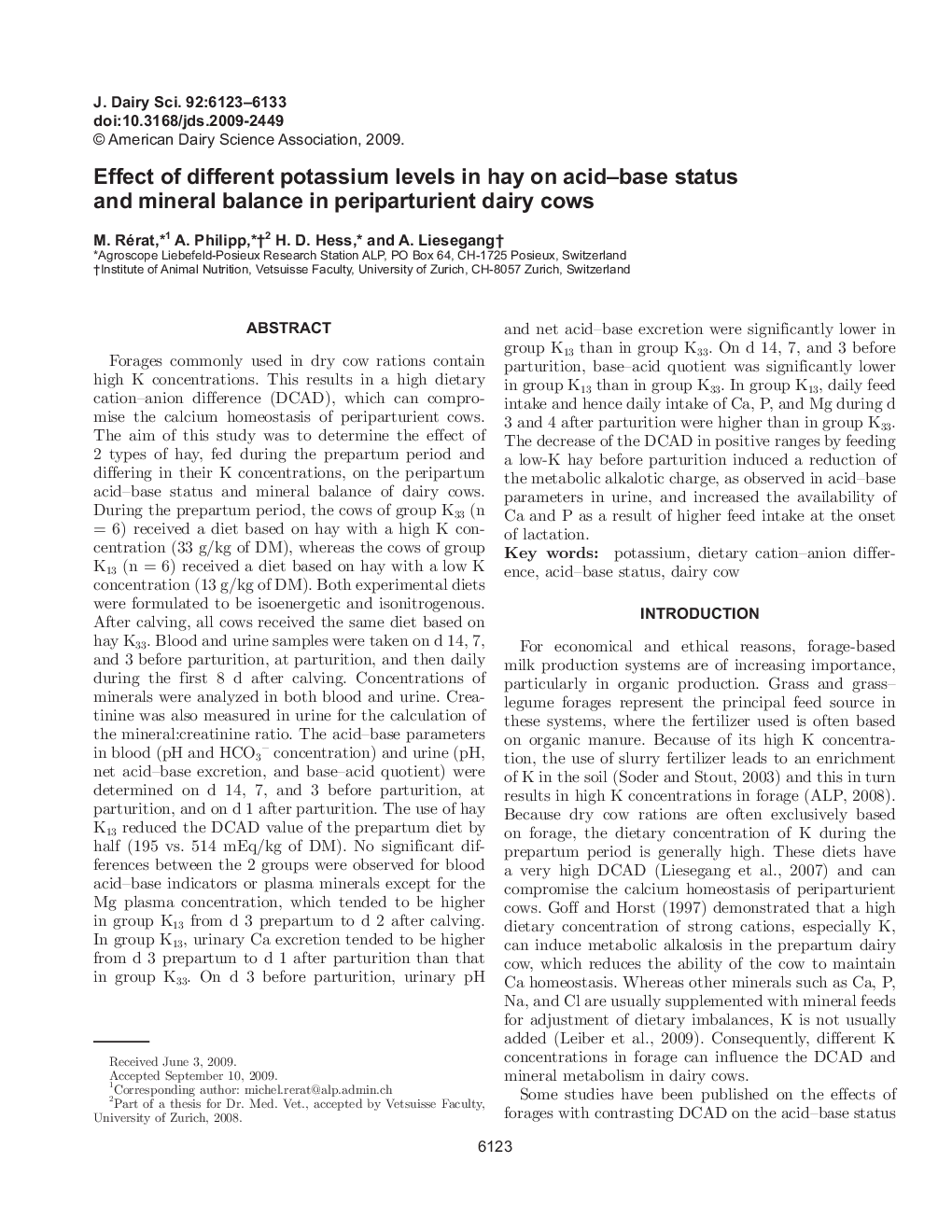| کد مقاله | کد نشریه | سال انتشار | مقاله انگلیسی | نسخه تمام متن |
|---|---|---|---|---|
| 2438954 | 1108082 | 2009 | 11 صفحه PDF | دانلود رایگان |
عنوان انگلیسی مقاله ISI
Effect of different potassium levels in hay on acid-base status and mineral balance in periparturient dairy cows
دانلود مقاله + سفارش ترجمه
دانلود مقاله ISI انگلیسی
رایگان برای ایرانیان
موضوعات مرتبط
علوم زیستی و بیوفناوری
علوم کشاورزی و بیولوژیک
علوم دامی و جانورشناسی
پیش نمایش صفحه اول مقاله

چکیده انگلیسی
Forages commonly used in dry cow rations contain high K concentrations. This results in a high dietary cation-anion difference (DCAD), which can compromise the calcium homeostasis of periparturient cows. The aim of this study was to determine the effect of 2 types of hay, fed during the prepartum period and differing in their K concentrations, on the peripartum acid-base status and mineral balance of dairy cows. During the prepartum period, the cows of group K33 (n = 6) received a diet based on hay with a high K concentration (33 g/kg of DM), whereas the cows of group K13 (n = 6) received a diet based on hay with a low K concentration (13 g/kg of DM). Both experimental diets were formulated to be isoenergetic and isonitrogenous. After calving, all cows received the same diet based on hay K33. Blood and urine samples were taken on d 14, 7, and 3 before parturition, at parturition, and then daily during the first 8 d after calving. Concentrations of minerals were analyzed in both blood and urine. Creatinine was also measured in urine for the calculation of the mineral:creatinine ratio. The acid-base parameters in blood (pH and HCO3â concentration) and urine (pH, net acid-base excretion, and base-acid quotient) were determined on d 14, 7, and 3 before parturition, at parturition, and on d 1 after parturition. The use of hay K13 reduced the DCAD value of the prepartum diet by half (195 vs. 514 mEq/kg of DM). No significant differences between the 2 groups were observed for blood acid-base indicators or plasma minerals except for the Mg plasma concentration, which tended to be higher in group K13 from d 3 prepartum to d 2 after calving. In group K13, urinary Ca excretion tended to be higher from d 3 prepartum to d 1 after parturition than that in group K33. On d 3 before parturition, urinary pH and net acid-base excretion were significantly lower in group K13 than in group K33. On d 14, 7, and 3 before parturition, base-acid quotient was significantly lower in group K13 than in group K33. In group K13, daily feed intake and hence daily intake of Ca, P, and Mg during d 3 and 4 after parturition were higher than in group K33. The decrease of the DCAD in positive ranges by feeding a low-K hay before parturition induced a reduction of the metabolic alkalotic charge, as observed in acid-base parameters in urine, and increased the availability of Ca and P as a result of higher feed intake at the onset of lactation.
ناشر
Database: Elsevier - ScienceDirect (ساینس دایرکت)
Journal: Journal of Dairy Science - Volume 92, Issue 12, December 2009, Pages 6123-6133
Journal: Journal of Dairy Science - Volume 92, Issue 12, December 2009, Pages 6123-6133
نویسندگان
M. Rérat, A. Philipp, H.D. Hess, A. Liesegang,